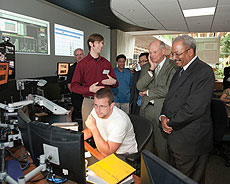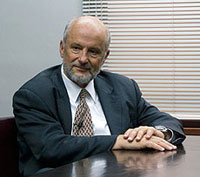|
Have a safe day!
Tuesday, July 19
10:30 a.m.
Research Techniques Seminar - Curia II
Speakers: Gustavo Cancelo and Juan Estrada, Fermilab
Title: Advances in CCD Applications with Sub Electron Noise Techniques
12 p.m.
Summer Lecture Series - Curia II
Speaker: Mark Pankuch, Central DuPage Hospital
Title: The Clinical Use of Accelerated Protons: Proton Radiotherapy
3:30 p.m.
DIRECTOR'S COFFEE BREAK - 2nd Flr X-Over
4 p.m.
Accelerator Physics and Technology Seminar - One West
Speaker: Moses Chung, Handong Global University, Korea
Title: What Can We Learn from the Beam Test of a Gas-Filled RF Cavity?
Wednesday, July 20
3:30 p.m.
DIRECTOR'S COFFEE BREAK - 2nd Flr X-Over
4 p.m.
Fermilab Colloquium - One West
Speaker: Toshiki Tajima, Ludwig Maximilian University, Munich
Title: Laser Wakefield Acceleration and Fundamental Physics
Click here for NALCAL,
a weekly calendar with links to additional information.
Upcoming conferences
|
|
Tuesday, July 19
- Breakfast: English muffin sandwich
- Creamy turkey vegetable soup
- Chili dog
- Country-fried steak
- Chicken cacciatore
- Italian panini w/ provolone
- Assorted sliced pizza
- Southwestern chicken burrito
Wilson Hall Cafe Menu
|
|
Wednesday, July 20
Lunch
- Yogurt marinated beef kabobs w/ wasabi aioli
- Greek chick pea salad
- Baklava
Friday, July 22
Dinner
Closed
Chez Leon Menu
Call x3524 to make your reservation.
|
|
Congressman Chaka Fattah visits Fermilab - July 18
 |
|
Fermilab scientist Aron Soha (left, in red shirt) explains to Congressman Chaka Fattah (far right) how the LHC Remote Operations Center is used to monitor the CMS experiment at CERN on his tour of Fermilab on July 18. His visit also included stops at the MINOS Underground Facility and the Superconducting Radio Frequency Test Facility. Also pictured are (left to right) Fermilab's Erik Gottschalk, University of Maryland's Jaime Gomez, Carnegie Mellon's Dongwook Jang, the DOE's congressional liason Clarence Tong and the DOE's director of the science office Bill Brinkman. |
|
A new neutrino oscillation
From the American Physical Society's Physics Viewpoint, July 18, 2011
The T2K collaboration in Japan sees strong hints of muon neutrino to electron neutrino oscillation.
Starting in the late 1960s, neutrino detectors began to see signs that neutrinos, now known to come in the flavors electron (νe), muon (νμ), and tau (ντ), could transform from one flavor to another. The findings implied that neutrinos must have mass, since massless particles travel at the speed of light and their clocks, so to speak, don’t tick, thus they cannot change.
What has since been discovered is that neutrinos oscillate at two distinct scales, 500 km/GeV and 15,000 km/GeV, which are defined by the baseline (L) of the experiment (the distance the neutrino travels) divided by the neutrino energy (E). Neutrinos of one flavor can oscillate into neutrinos of another flavor at both L/E scales, but the amplitude of these oscillations is different for the two scales and depends on the initial and final flavor of the neutrinos. The neutrino states that propogate unchanged in time, the mass eigenstates ν1, ν2, ν3, are quantum mechanical mixtures of the electron, muon, and tau neutrino flavors, and the fraction of each flavor in a given mass eigenstate is controlled by three mixing angles and a complex phase. Two of these mixing angles are known with reasonable precision.
Read more
|
Summer conference preview: Is it Bs?
Here we are, just eight days away from the start of the EPS conference, the first big meeting of the summer conference season. You can bet that all of the LHC experiments are racing to come up with results that will make as big a splash as possible there. (Or, failing that, at DPF two and a half weeks later, or Lepton-Photon two weeks after that.)
However, even before then, we have the first interesting result of the season in a paper submitted by CDF just yesterday. The topic is a search for a Bs meson that decays to a μ+μ- pair. The Bs is made of a bottom antiquark and strange quark, and a student in an introductory particle physics course would (or should) tell you immediately that this decay can’t happen, as the standard model doesn’t allow for any “flavor changing neutral currents”, and there is no means for these two quarks of different flavors to annihilate each other. But a student in the next course would (or should) point out that no FCNC only applies to leading-order processes, and that there are higher-order, more rare interactions that would allow or this.
Read more
— Ken Bloom
|
Fermilab history revived in Winnetka
From Examiner.com, July 15, 2011
Adrienne Kolb, Fermilab archivist and co-author of Fermilab: Physics, the Frontier, and Megascience, presented her new book last Tuesday, July 12, at the The Book Stall at Chestnut Court in Winnetka.
Ms. Kolb opened her lecture with a description of Frederick Jackson Turner and his concept of the frontier; Turner, she explained, believed America was built and would prosper on the edge.
And on the edge of Chicago, in the suburb of Weston, Turner’s theory would manifest itself as Fermilab. Fermilab existed on the edge of particle physics—because when the West was won it was science that became the next frontier.
Founded in the late ’60s by Robert Wilson, the laboratory spent months looking for a home in Chicago’s suburbs. Barrington was the initial choice—but residents of the affluent suburb opposed its construction.
Read more
|
|
One more piece falls into place
 |
|
Fermilab Director Pier Oddone
|
The National Research Council (NRC) has concluded its Assessment of the Deep Underground Science and Engineering Laboratory (DUSEL) . NRC reports are produced by expert committees, in this case a committee under the leadership of Professor Andy Lankford of the University of California at Irvine. The committee tackled the charge from NSF and DOE to provide an independent assessment of the physics questions that could be addressed with the proposed DUSEL program. These questions include what impact such a program would have on the stewardship of the research communities involved and whether there was a need to develop such a program in the United States.
The charge was given to the committee before the NSF Science Board’s decision to stop the interim funding for the DUSEL facility. The charge to the NRC Committee was complementary to the charge the DOE later gave to the Committee to Evaluate DOE-SC Options for Underground Science led by Jay Marx and Mark Reichanadter. The NRC panel was charged with evaluating the science, while the Marx/Reichanadter committee assessed the costs of the various options for the development of a deep underground program. These two reports are necessary inputs for DOE as it moves toward a decision about the development of a deep underground experimental site at Homestake.
The NRC report makes a very strong case for the science of an underground laboratory. For three of the proposed physics experiments—a direct-detection dark-matter experiment on a scale of one to tens of tons; a long-baseline neutrino oscillation experiment; and a ton-scale, neutrino-less double-beta-decay experiment—the panel concluded that they are “of paramount and comparable scientific importance. Each of these experiments addresses at least one crucial question upon which the tenets of our understanding of the universe depend.”
The report also states that “exceptional opportunities will result from proceeding with plans to build in the United States a world-leading long-baseline neutrino experiment and developing within the United States both one direct dark matter detection experiment on the ton to multi-ton scale and one neutrino-less double-beta decay experiment on the ton scale, for installation at a U.S. site or if such a site is not available, at an appropriate overseas facility.”
These conclusions from the NRC Committee make a strong case for a deep underground laboratory. The Marx/Reichanadter Committee concluded that the option to share infrastructure for these three experiments would allow the economic development of such a site. The two committees’ reports give us as solid a foundation as we could have hoped for moving forward.
|
|